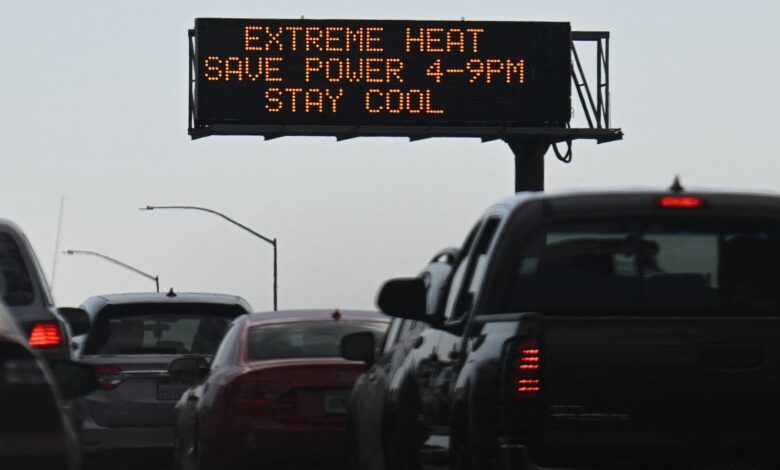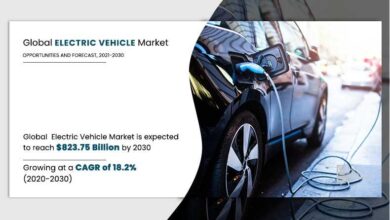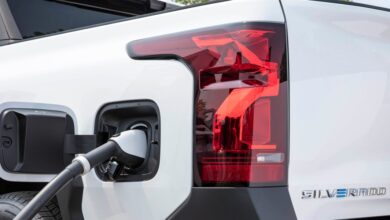Here’s How The ‘Heat Dome’ Will Test The Mettle Of EV Owners This Week

Some of the biggest states for EV adoption will be suffering range-sapping triple-digit temperatures … [+]
Those who own electric vehicles and live within the path of the so-called heat dome that’s expected to send temperatures sizzling well into triple digits this week should heed the words of the great Yogi Berra, who once declared, “It’s déjà vu all over again.”
Following last year’s cruel summer, excessive heat warnings have already been issued for nearly 19 million people residing in southwestern states that include California, Nevada, Utah and Arizona, with the heat dome expected to expand further southeast and up and into the Pacific Northwest by week’s end. Thursday will be the hottest day of the week – perhaps in history – for millions of Americans.
As it turns out, this includes some of the states having the most EV registrations in the nation, led by California, where 4.3% of all light-duty vehicles are now battery powered, according to the Alternative Fuels Data Center. Other EV-heavy states expected to suffer soaring temperatures at 20 to 25 degrees above normal include Oregon, Washington, Colorado, Texas and Florida.
All told, those states alone are home to more than 1.55 million EV owners who, if they didn’t learn during last year’s brutal heat waves, will discover to what degree their rides are hampered in terms of battery range and charging abilities when ambient temperatures reach the upper end of Dr. Fahrenheit’s scale.
According to testing conducted by the Society of Automotive Engineers (SAE), an EV can be expected to lose an average 17% of its effective range when the temperature reaches 95 degrees. A study released by the EV data tracking company Recurrent determined a given model’s battery capacity can drop by as much as 31% in 100-degree weather.
As with most of us, an EV prefers more temperate conditions, with a zero loss of range expected while driving at 75 degrees.
Like an internal combustion vehicle (ICE), it takes additional energy to drive a car on a hot day with the air conditioning running, though the penalty is more pronounced with an EV. In addition, charging an EV in extremely hot weather can cause chemical reactions that places undue stress on the battery, which can both adversely affect its range as well as its longevity. That’s why many models now include systems that will automatically slow charging speeds as needed if the battery is becoming overheated.
While such losses will vary from one model EV to another, and according to a variety of external factors, it underscores the fact that EV owners need to anticipate attaining fewer miles on a charge in extremely hot weather, and adjust both their driving styles and expectations accordingly. It’s also wise to keep a watchful eye on an EV’s state-of-charge indicator and be aware of where a second nearest in the event one’s first choice is busy or broken (as is still too-often the case).
Take note that those living in cooler climates don’t catch a break in this regard, in fact they can suffer even more when the mercury plunges. Cold weather testing conducted by SAE indicates EVs can lose around 41% of their battery capacity at 20 degrees Fahrenheit, and even more when temps hit the zero-degree mark, with significantly longer charging times in the process. Again, about two-thirds of the extra energy consumed in frigid climates can be blamed on an EV’s climate control system, which doesn’t have the luxury of harvesting heat from an ICE engine.
Either way, there are a number of proactive ways to wring the most miles out of an EV and maintain battery health in extreme weather.
For starters, experts suggest parking an EV in a garage or covered parking lot—or at the least in a shaded area—to help minimize exposure to the scorching sun. It’s a good idea to pre-cool the vehicle remotely while it’s charging (using an app or timer function on a home charger) to tap the power grid instead of the battery to bring down internal temperatures. That will likely save several miles of battery range by not immediately over-taxing the vehicle’s air conditioning.
For better or worse it’s also helpful to run the air conditioning sparingly while driving, especially at highway speeds where EV energy consumption is automatically greater than it is during stop-and-go around town use. This is where having ventilated seats can come in handy, as they cool one from the bottom up while using far fewer kilowatts than running an A/C compressor. An even better strategy is to avoid driving and/or charging an EV during the hottest times of the day if that’s an option.
Engage an EV’s “eco” or “battery saver” mode if it’s so equipped to conserve energy, and use the vehicle’s maximum regenerative braking setting to send energy back to help charge the battery that would otherwise be lost while slowing down and coming to a stop. Many models allow so-called “one pedal” driving in which the function is dialed up enough to enable the vehicle to reach a complete stop, at or at least close to it, without using the brakes. One-pedal driving also has the added bonus of minimizing brake system wear.
Experts suggest EV owners maintain no more than an 80% charge to help prevent a loss in capacity down the road. That’s because maxing out to a full charge places added stress on the battery. Rely as much as possible on home charging and avoid using public Level 3 DC Fast Charge stations unless absolutely necessary, as they can accelerate battery degradation, especially in hot climates.
Otherwise, many of the same strategies for saving fuel in a gas-engine vehicle apply to maximizing an EV’s operating range. This means avoiding jackrabbit starts and abrupt stops, keeping tires properly inflated to the recommended PSI (pounds per square inch), carrying the lightest load possible and minimizing a model’s wind resistance at higher speeds by keeping the windows closed and relying on the climate control vents to circulate air throughout the cabin, using the AC only sparingly.



